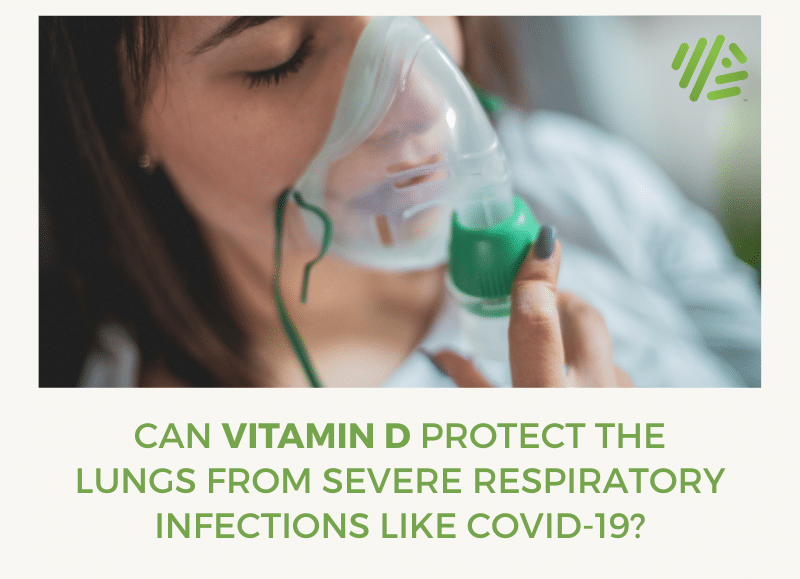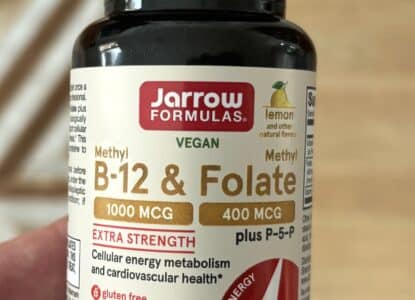Can Vitamin D Protect the Lungs From Severe Respiratory Infections Like COVID-19?

Contents
Like it or not, the novel coronavirus (“COVID-19”) is on everyone’s mind and it’s likely to stay that way for the foreseeable future. Unfortunately, COVID-19 has become such a ubiquitous topic that many in the health and wellness community have rushed to publish listicles on tips for “boosting the immune system.”
While some of these posts have value, many have the potential to mislead the public.
It’s important to state very clearly that there is no known supplement that can prevent COVID-19 infection. Let me repeat, there is not a supplement that will prevent you from getting COVID-19.
Having said that, there is a tremendous disparity between how certain groups of people experience coronavirus when they become infected.
Some, especially high risk populations, such as those living in nursing homes, Americans above age 65, people suffering from hypertension and type 2 diabetes, and those with existing lung problems are at higher risk for complications stemming from a COVID-19 infection. While some with COVID-19 have gastrointestinal, rather than respiratory symptoms, the most publicized cases are of COVID-19 are the ones requiring “intubation” and ventilators for breathing assistance.
Study: Vitamin D decreases severity of respiratory infections
As such, those of us who looking for natural ways to reduce the likelihood of a severe COVID-19 case that results in hospitalization may want to pay special attention to our vitamin D levels.
The BMJ, a weekly peer reviewed medical journal, which, yes, was formerly known as the British Medical Journal in a past life, published a meta-analysis of studies in 2017 that evaluated whether vitamin D supplementation could reduce the risk of severe respiratory infections in those suffering from the flu.
The BMJ research saw a significant reduction in severe respiratory infections when vitamin D supplements were administered to subjects.
The greatest benefits were found in the following groups:
- Those already vitamin D deficient (defined as < 25 nmol/L) and;
- Those who took a steady dose rather than a mega “bolus” dose
Breaking down the vitamin D lung infection study
Respiratory infections are a burden on our healthcare system
The BMJ study, which was performed in 2017, obviously didn’t look at our current crisis, COVID-19, and so when I first saw how large the study was (a compilation of 25 studies looking at a pool of over 11,000 subjects), I was curious why the researchers would devote so much time to this subject matter in a pre-coronavirus world.
That was until I read this opening line from their analysis:
Acute respiratory tract infections are a major cause of global morbidity and mortality and are responsible for 10% of ambulatory and emergency department visits in the USA and an estimated 2.65 million deaths worldwide in 2013.
I had no idea just how big of a problem respiratory infections are under normal circumstances, let alone during a rapidly spreading global pandemic that attacks the lungs.
Flu seasonality could be explained by vitamin D exposure
Perhaps the most interesting thing I found digging into the BMJ vitamin D meta-analysis was a cite to an observational study on the seasonality of flu and vitamin D levels. Titled Epidemic influenza and vitamin D, the study authors believe part of the reason the seasonal flu (also a type of coronavirus) wanes in summer is people have a stronger immune response due their increased vitamin D levels brought on bu exposure to sunlight.
To quote the epidemiologists who published the paper:
Ultraviolet radiation (either from artificial sources or from sunlight) reduces the incidence of viral respiratory infections, as does cod liver oil (which contains vitamin D). An interventional study showed that vitamin D reduces the incidence of respiratory infections in children. We conclude that vitamin D, or lack of it, may be Hope-Simpson’s ‘seasonal stimulus’.
The vitamin D theory for flu seasonality is especially interesting in light of this prescient analysis of likely COVID-19 hot spots published by researchers at the University of Maryland Medical School, which evaluated the weather patterns of cities that were particularly hard hit by coronavirus through community spread. The paper highlights a band of between 30-50 degrees north latitude with temperatures of between 5-11 degrees celsius as most vulnerable to community spread.
Vitamin D enhances the local immune system in the lungs
Many of us know vitamin D, as a fat soluble vitamin that helps us absorb calcium, is critical to bone health.
However, vitamin D also plays a key role in a healthy immune system as well. How and why is vitamin D able to boost the ability of the lungs to fight off infection?
Numerous test tube studies, called in vitro studies, demonstrate that vitamin D helps increase peptides the immune system uses to increase production of immune cells our body’s use to destroy pathogens. 1 Put another way, the vitamin D receptor is expressed on immune cells and these cells can use vitamin D metabolites as “food” to build stronger and better B and T cells (the types of cells we use to fight back against infection). 2
When we have adequate vitamin D, the lungs in particular can make more protective immune cells, which in turn helps to fight off infection. The BMJ study found the most protective effect from supplementing when those who were vitamin D deficient boosted their vitamin D levels.
The next logical question from there is, how many of us are vitamin D deficient and how can we get our vitamin D levels tested?
Prevalence of vitamin D deficiency
The BMJ meta-analysis I have been discussing in this post defined vitamin d deficiency as levels less than 25 nmol/L.
When I get my vitamin D levels tested through Cleveland Heart Labs as part of a comprehensive lipid panel, I sometimes see levels as low as 28 nmol/L in the winter months.
In my Gene Food Nutrition Report, I am categorized as someone who could benefit from vitamin D supplementation, so this makes sense, in part based on my VDR genotype. As such, I am focusing on ways, either through sunlight or supplements, to boost my vitamin D levels during the coronavirus crisis especially.
Particularly in the winter months, I appear to run low on vitamin D levels.
How many others have this issue?
It’s tough to say exactly as estimates and levels of vitamin D considered optimal vary from study to study, but by one account from the National Health and Nutrition Examination Survey (NHANES), “insufficient” vitamin D levels were found in 41.6% of the almost 4,500 people measured for vitamin D deficiency. 3
In the NHANES study, insufficient vitamin D was defined as less than 50 nmol/L, which is a far greater threshold for vitamin D deficiency than was used by the BMJ meta-analysis. Studies have found that obesity is linked with vitamin D deficiency. We also tend to see African American populations suffering with more regularity from vitamin D deficiency. According to the NHANES study, 82.1% of African Americans had levels of vitamin D below 50 nmol/L. It is interesting that two groups who have suffered disproportionately from COVID-19, African Americans and those struggling with obesity, are also groups more likely to be deficient in a vitamin demonstrated to have some efficacy in protecting the lungs from severe respiratory infections. 3
New studies on COVID-19 severity and vitamin D status
This is a rapidly developing area of research, but there is a tenuous scientific consensus emerging that vitamin D status may play a significant role in determining who has a serious COVID-19 infection.
A team of scientists led by Northwestern University conducted a statistical analysis of all the countries hardest hit by the coronavirus. Countries included in the modeling were China, Italy, Spain, Iran, the United States, Germany, Switzerland, the UK, and South Korea.
The scientists found a connection between serious COVID-19 complications and vitamin D.
While the researchers stopped short of recommending everyone take vitamin D as a supplement, they did find a significant association between vitamin D status and COVID-19 mortality rates, suggesting that having adequate levels of vitamin D could cut COVID-19 mortality rates in half.
Key takeaways
- The research on vitamin D and immune function in the lungs is promising for the flu, however, despite promising research it’s still too early to say exactly how vitamin D levels could affect the severity of COVID-19 infections;
- In previous studies, the greatest protective effect against respiratory infection was seen in those who had low levels of vitamin D to begin with (< 25 nmol/L);
- Mega-doses of vitamin D didn’t show benefit, instead, steady, slow dosing was most effective.



